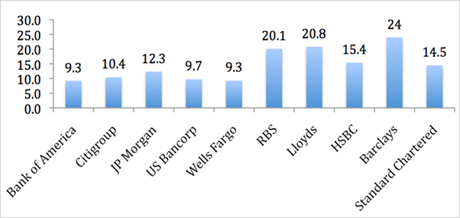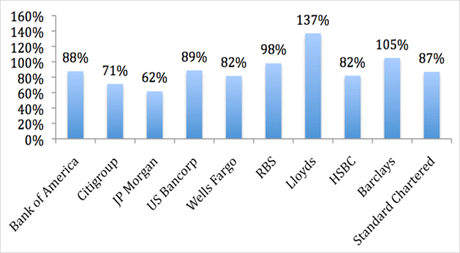Is it time to buy American banks?
Despite the continuing fragility of the US economy, American banks are in much better shape than British banks. So is it time to buy them? Phil Oakley examines whether they're worth putting your money into.
At first glance, there's not much to cheer about in America. Unemployment remains high, and it has horrendous financial problems with trillion-dollar deficits and ballooning government debts.
Yet compared to most other parts of the world, America has a lot going for it.
There's the potential offered by shale gas and oil, for a start. In the long run, all that home-grown cheap energy could be very good news for both the dollar and for US manufacturing.
MoneyWeek
Subscribe to MoneyWeek today and get your first six magazine issues absolutely FREE

Sign up to Money Morning
Don't miss the latest investment and personal finances news, market analysis, plus money-saving tips with our free twice-daily newsletter
Don't miss the latest investment and personal finances news, market analysis, plus money-saving tips with our free twice-daily newsletter
As for the nearer-term, at least the US unlike Britain has had a proper correction in its housing market. The Case/Shiller Index measuring house prices in 20 US cities is down 35% from its mid-2006 peak.
We've already looked at why we think US property could be a good long-term buy. But what about US banks? With the worst of the housing bust behind them, and better-looking balance sheets than their British peers, are America's banks a buy?
US banks are in better shape than British ones
If you look at the balance sheets of the five biggest mortgage lenders in the US, they seem to be in much better shape than their UK peers.
UK/US banks 2011 leverage ratios

While HSBC and Standard Chartered look reasonably well-financed, the US banks listed here are substantially less leveraged (that is, their assets are backed by more equity) than Barclays, Lloyds Banking Group and RBS - for example, Barclays is levered 24 times compared with Wells Fargo or Bank of America on 9.3 times.
Let's be clear - being leveraged ten times is still frighteningly high compared with an industrial company. But it seems fair to say that the five US banks above have a better ability to absorb economic shocks than UK banks. And even now, US regulators seem intent on getting the banks to hold even more capital to protect themselves against bad times.
Another plus-point for the US banks is that they are entirely funded by deposits and not reliant on the money markets to finance their loan portfolios any more. In other words, they are lending out less money than they have in deposits.
2011 loan to deposit rates

Again, HSBC and Standard Chartered are the pick of the UK-listed banks on this measure. All the US banks above have enviable loan financing arrangements compared to Lloyds, for example, which has a significant funding gap'.
A contrarian investment or a value trap?
It's perhaps little wonder that some analysts now see the sector as a contrarian investment opportunity. I've broken down the data in the table below.
| Bank of America | 7.5 | 80.72 | 0.042 | 0.6% | 0.35 | 11.4 |
| Citigroup | 27.6 | 80.99 | 0 | 0.0% | 0.45 | 6.7 |
| JP Morgan | 33.8 | 124.94 | 1.19 | 3.5% | 0.68 | 7.8 |
| US Bancorp | 30.6 | 58 | 0 | 0.0% | 1.66 | 11.1 |
| Wells Fargo | 31.3 | 166.33 | 0.852 | 2.7% | 1.17 | 9.6 |
Citigroup in particular is seen as a beaten-up, potential value investing candidate. It trades on less than half of its book value, and on a 2012 price to earnings (p/e) ratioof 6.7 times.
But while US banks certainly seem to hold much less risk for the US economy, than British banks do for Britain, I'm not yet convinced that it's time to pile in.
The trouble is that when you invest in a bank, you really have no idea about what you own. There might be some nasty surprises lurking on their balance sheets.
And even if there aren't, you have to remember that a balance sheet is just a snapshot of a business on one particular day. A balance sheet can look a lot different a month or even a week later, depending on the type of business. Very few, if any outside investors can work out what's going on.
This is particularly true of banks with big investment banking divisions. The recent large trading losses at JP Morgan are a timely reminder of the risks that investors face here.
Other potential risks include house prices: while the US market is probably nearer to bottoming out than our own, prices are still falling in many areas. And while the US banks may be relatively safe from the fallout of a eurozone crisis, we won't know for sure if this is true until after the event. There's still a chance that some assets might have to be written down in value.
Wells Fargo looks the pick of the bunch
So in all, I don't plan to invest in the US banking sector. However, I realise that some of you are less conservative investors than I am, and may feel like dipping a toe in the water.
So if forced to choose one to invest in, I'd probably look at Wells Fargo (NYSE: WFC), which is a holding of Warren Buffett's Berkshire Hathaway investment vehicle. Its core business is retail and commercial banking. It has some investment banking business, but unlike some of its peers this does not dominate the company.
Wells Fargo is doing well in its mortgage banking business, which helped the group to report record profits during the first three months of 2012. It is also growing its returns on equity up to 12%, despite relatively low leverage which is also good sign. Meanwhile, bad loans are declining and it continues to attract more deposit financing.
Wells Fargo looks like a steady, lower-risk investment in this sector. Reflecting this, it trades at a modest premium to book value, but it looks well placed to grow dividends while offering a 2012 forecast dividend yield of 2.7%.
If the sector as a whole recovers, Wells should benefit from any improved sentiment. If it doesn't, then Wells should be among the least heavily exposed to any fresh slump.
This article is taken from the free investment email Money Morning. Sign up to Money Morning here .
Our recommended articles for today
Has the gold price bottomed out?
After topping out at over $1,900 an ounce, the price of gold tumbled to around $1,500. But now it looks to be rising again. Matthew Partridge looks at what's in store for gold.
How to profit from the football feeding frenzy: buy BT
By buying the rights to live Premier League football, BT is venturing into uncharted territory. But can it succeed where others have failed? Phil Oakley investigates.
Get the latest financial news, insights and expert analysis from our award-winning MoneyWeek team, to help you understand what really matters when it comes to your finances.
Phil spent 13 years as an investment analyst for both stockbroking and fund management companies.
After graduating with a MSc in International Banking, Economics & Finance from Liverpool Business School in 1996, Phil went to work for BWD Rensburg, a Liverpool based investment manager. In 2001, he joined ABN AMRO as a transport analyst. After a brief spell as a food retail analyst, he spent five years with ABN's very successful UK Smaller Companies team where he covered engineering, transport and support services stocks.
In 2007, Phil joined Halbis Capital Management as a European equities analyst. He began writing for MoneyWeek in 2010.
-
 My 6.5% Nationwide regular saver is due to mature - what are my options?
My 6.5% Nationwide regular saver is due to mature - what are my options?Nationwide’s 6.5% regular saver is due to mature for those who opened one last year. Here is what you can do now to make the most of your savings
-
 Leading European companies offer long-term growth
Leading European companies offer long-term growthOpinion Alexander Darwall, lead portfolio manager, European Opportunities Trust, picks three European companies where he'd put his money